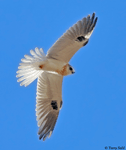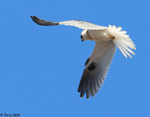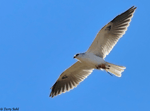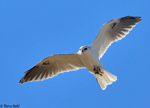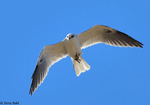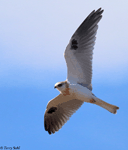| Length: 16 inches | Wingspan: 40 inches | Seasonality: Extremely rare visitor |
| ID Keys: White underparts and head, gray above with black shoulder | ||
 Once considered endangered
in North America, the White-tailed Kite has greatly expanded in numbers and
range since the 1930s. They are heavily dependent upon large populations
of small rodents such as mice and voles, and probably have benefited greatly
from the introduction of the House Mouse to North America. Previously
known as the Black-shouldered Kite.
Once considered endangered
in North America, the White-tailed Kite has greatly expanded in numbers and
range since the 1930s. They are heavily dependent upon large populations
of small rodents such as mice and voles, and probably have benefited greatly
from the introduction of the House Mouse to North America. Previously
known as the Black-shouldered Kite.
Habitat: Prefers open habitats with perches for hunting, and with suitable nesting sites. This includes marshes and wetlands, farmland, grassland, and prairie.
Diet: Primarily feeds on small rodents, especially mice and voles. Will also eat other small mammals, birds, and occasionally snakes, lizards, frogs, and large insects.
Behavior: Hunts in flight, hovering to spot prey, and then diving to catch it.
Breeding: Non-breeder in South Dakota
Song: White-tailed Kite (pair of breeding adults), White-tailed Kite "Whistle-croak" call
Migration: Generally a permanent resident throughout its normal range, but individuals can wander widely.
Interactive eBird map: Click here to access an interactive eBird map of White-tailed Kite sightings
Similar Species: Mississippi Kite
Conservation Status: Has increased in numbers and range since the early 20th century, when it was persecuted needlessly by farmers who thought it threatened their poultry. Now found in areas it wasn't known historically. Numbers are strong, they are found across a broad geographic area, and they are common in parts of their range. The IUCN considers the White-tailed Kite to be a species of "Least Concern".
Further Information: 1) USGS Patuxent Bird Identification InfoCenter, White-tailed Kite
2) WhatBird - White-tailed Kite
3) BirdWeb - White-tailed Kite
Photo Information: November 11th, 2015 - Las Cinegas Natural Conservation Area, near Tucson, Arizona - Terry Sohl
| Click on the range map for a higher-resolution view |
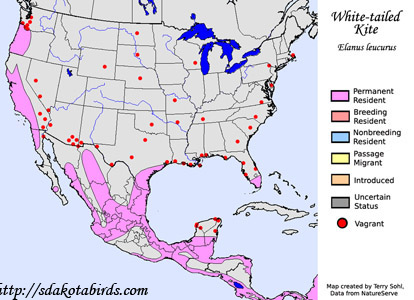 |
| South Dakota Status: Accidental, with only a handful of records in the state. |
Additional White-tailed Kite Photos
